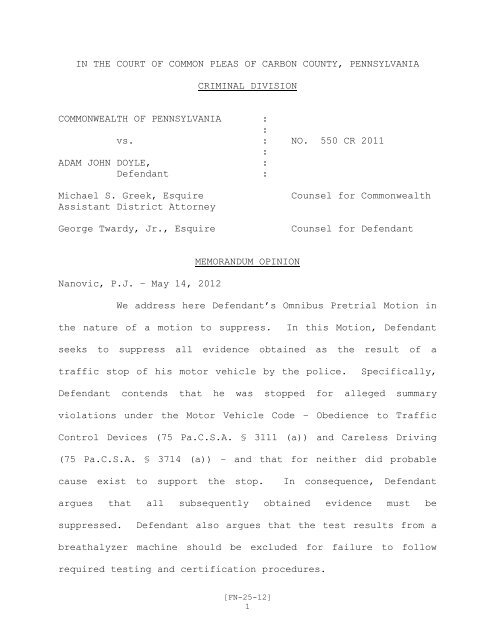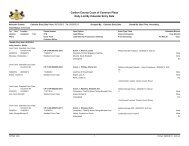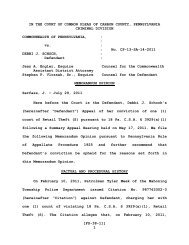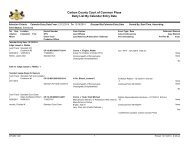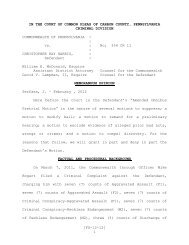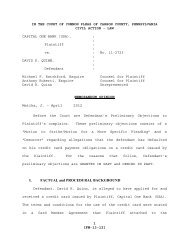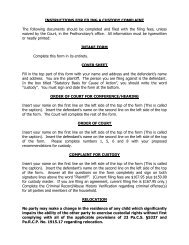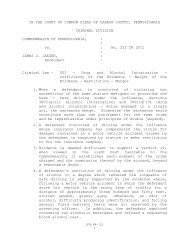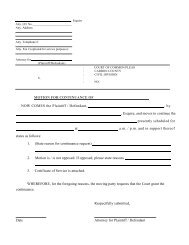commonwealth v adam doyle.pdf - Carbon County Courts
commonwealth v adam doyle.pdf - Carbon County Courts
commonwealth v adam doyle.pdf - Carbon County Courts
Create successful ePaper yourself
Turn your PDF publications into a flip-book with our unique Google optimized e-Paper software.
IN THE COURT OF COMMON PLEAS OF CARBON COUNTY, PENNSYLVANIA<br />
CRIMINAL DIVISION<br />
COMMONWEALTH OF PENNSYLVANIA :<br />
:<br />
vs. : NO. 550 CR 2011<br />
:<br />
ADAM JOHN DOYLE, :<br />
Defendant :<br />
Michael S. Greek, Esquire<br />
Assistant District Attorney<br />
George Twardy, Jr., Esquire<br />
Counsel for Commonwealth<br />
Counsel for Defendant<br />
Nanovic, P.J. – May 14, 2012<br />
MEMORANDUM OPINION<br />
We address here Defendant’s Omnibus Pretrial Motion in<br />
the nature of a motion to suppress.<br />
In this Motion, Defendant<br />
seeks to suppress all evidence obtained as the result of a<br />
traffic stop of his motor vehicle by the police.<br />
Specifically,<br />
Defendant contends that he was stopped for alleged summary<br />
violations under the Motor Vehicle Code – Obedience to Traffic<br />
Control Devices (75 Pa.C.S.A. § 3111 (a)) and Careless Driving<br />
(75 Pa.C.S.A. § 3714 (a)) – and that for neither did probable<br />
cause exist to support the stop.<br />
In consequence, Defendant<br />
argues that all subsequently obtained evidence must be<br />
suppressed.<br />
Defendant also argues that the test results from a<br />
breathalyzer machine should be excluded for failure to follow<br />
required testing and certification procedures.<br />
[FN-25-12]<br />
1
FACTUAL AND PROCEDURAL HISTORY<br />
On March 13, 2011, at approximately 6:40 P.M.,<br />
Defendant was operating a pickup truck driving north on State<br />
Route 209 at or near its intersection with Broadway in Jim<br />
Thorpe, <strong>Carbon</strong> <strong>County</strong>, Pennsylvania. Defendant was stopped at a<br />
red light waiting to make a left-hand turn.<br />
At the location<br />
where Defendant was stopped, two restricted lanes existed:<br />
one<br />
for traffic headed straight onto Broadway and one for traffic<br />
intending to turn left to continue on Route 209 north.<br />
Defendant’s truck was straddling both lanes, with approximately<br />
half of his vehicle in the right lane and half in the left lane.<br />
Trooper Michael Walsh of the Pennsylvania State Police<br />
was driving south on Route 209.<br />
Upon observing the position of<br />
Defendant’s stopped vehicle, he immediately made a U-turn and<br />
pulled behind Defendant’s vehicle. When the light turned green,<br />
Defendant turned left. As he did so, Trooper Walsh observed the<br />
right-hand portion of Defendant’s vehicle come within inches of<br />
striking the sidewalk curb. At this location, Route 209 has one<br />
lane proceeding north and there is no adjacent shoulder. At the<br />
time of the incident, a St. Patrick’s day parade was concluding<br />
and people were in the area.<br />
However, there was no evidence<br />
that any pedestrian was startled or in danger of being harmed.<br />
[FN-25-12]<br />
2
At this point, Trooper Walsh initiated a traffic stop.<br />
Defendant responded appropriately and pulled over at a safe<br />
location.<br />
As Trooper Walsh spoke with Defendant, he smelled an<br />
odor of alcohol, administered a PBT test, and conducted an HGN<br />
assessment, all of which indicated intoxication.<br />
Defendant was arrested and transported to the<br />
Pennsylvania State Police barracks in Lehighton.<br />
At 7:17 P.M.,<br />
Defendant was given and acknowledged his implied consent<br />
warnings. At 7:32 P.M., he performed the requested breathalyzer<br />
test. The results revealed a blood alcohol content of 0.105<br />
percent.<br />
Defendant was charged with Driving Under the Influence<br />
(75 Pa.C.S.A. § 3802 (a)(1), (b)), Obedience to Traffic Control<br />
Devices, Careless Driving, and Failure to use a Seat Belt (75<br />
Pa.C.S.A. § 4581 (a)(2)).<br />
Defendant’s Omnibus Pretrial Motion<br />
was filed on September 8, 2011. Therein, Defendant alleges that<br />
Trooper Walsh “had no prior notice or reasonable suspicion as to<br />
the existence of [motor vehicle] violations prior to stopping<br />
Defendant” and that “all fruits of the illegal stop . . .,<br />
including his arrest by Trooper Walsh must be suppressed, as no<br />
reasonable suspicion or probable cause existed warranting the<br />
traffic stop at issue and as such, the stop was<br />
unconstitutional.”<br />
(Omnibus Pretrial Motion, paragraphs 8 and<br />
9). At the hearing held on this Motion, Defendant also argued<br />
[FN-25-12]<br />
3
that Trooper Walsh failed to observe him for twenty consecutive<br />
minutes immediately preceding the administration of the breath<br />
test as required by 67 Pa.Code § 77.24, and that the<br />
Commonwealth failed to present independent evidence that the<br />
simulator solution or ampoules used in testing the breathalyzer<br />
machine met testing standards, both of which require suppression<br />
of the breathalyzer test.<br />
DISCUSSION<br />
a) Legality of Stop<br />
As to Defendant’s primary argument, the legality of<br />
the stop, the initial question presented is whether probable<br />
cause must support Defendant’s traffic stop for the suspected<br />
motor vehicle code violations observed by Trooper Walsh, or<br />
whether reasonable suspicion is sufficient.<br />
This question<br />
concerns the quantum of proof required to support Defendant’s<br />
stop for alleged violations of the Vehicle Code.<br />
In 1995, this question was answered by the<br />
Pennsylvania Supreme Court based upon its interpretation of the<br />
language contained in Section 6308 (b) of the Vehicle Code, 75<br />
Pa.C.S.A. § 6308 (b), as it then existed.<br />
At the time, Section<br />
6308 (b) provided that an officer must have “articulable and<br />
reasonable grounds to suspect a violation of [the Vehicle Code]”<br />
before effecting a vehicle stop.<br />
Finding the term “articulable<br />
[FN-25-12]<br />
4
and reasonable grounds” to be the equivalent of “probable<br />
cause,” the Supreme Court held probable cause was a statutory<br />
prerequisite for a traffic stop of a motor vehicle premised upon<br />
a perceived belief by an officer that the vehicle or its driver<br />
was in violation of some provision of the Vehicle Code.<br />
Commonwealth v. Whitmyer, 668 A.2d 1113, 1116 (Pa. 1995).<br />
The holding in Whitmyer was dictated by the Court’s<br />
construction of the standard set by statute, not that set by<br />
either the federal or state constitutions. From a<br />
constitutional perspective, a traffic stop for Vehicle Code<br />
offenses is reasonable and constitutionally sound under both the<br />
Fourth Amendment to the United States Constitution and Article<br />
I, § 8 of the Pennsylvania Constitution, when an objective<br />
review of the facts underlying the stop shows that the officer<br />
possessed specific, articulable facts that the driver was<br />
violating a traffic law at the time of the stop.<br />
Under this<br />
standard, either probable cause or reasonable suspicion with the<br />
intent of conducting an investigation, will support the stop.<br />
The rationale for an investigatory stop upon reasonable<br />
suspicion is just that, the totality of the circumstances<br />
forming the basis of reasonable suspicion must be such that a<br />
stop under such circumstances supports an investigatory purpose.<br />
“Put another way, if the officer has a legitimate expectation of<br />
investigatory results, the existence of reasonable suspicion<br />
[FN-25-12]<br />
5
will allow the stop – if the officer has no such expectations of<br />
learning additional relevant information concerning the<br />
suspected criminal activity, the stop can not be<br />
constitutionally permitted on the basis of mere suspicion.”<br />
Commonwealth v. Chase, 960 A.2d 108, 115 (Pa. 2008).<br />
A stop based on reasonable suspicion requires that<br />
there be something to investigate. Therefore, if the only basis<br />
for the stop is reasonable suspicion that the detained motorist<br />
is presently involved in criminal activity, the violation being<br />
investigated must be such that evidence from the investigation<br />
will either confirm or negate the violation.<br />
“[A] vehicle stop<br />
based solely on offenses not ‘investigatable’ cannot be<br />
justified by a mere reasonable suspicion, because the purposes<br />
of a Terry stop do not exist – maintaining the status quo while<br />
investigating is inapplicable where there is nothing further to<br />
investigate.<br />
An officer must have probable cause to make a<br />
constitutional vehicle stop for such offenses.” Chase, 960 A.2d<br />
at 116.<br />
The Act of September 30, 2003, P.L. 120, No. 24, § 17,<br />
effective February 1, 2004, amended Section 6308 (b) of the<br />
Vehicle Code to set the standard for a vehicle stop at the<br />
constitutional level, thus replacing the higher statutory<br />
threshold presented in Whitmyer. Chase, 960 A.2d at 112;<br />
Commonwealth v. Fulton, 921 A.2d 1239, 1240 n.2 (Pa.Super.<br />
[FN-25-12]<br />
6
2007), appeal denied, 934 A.2d 72 (Pa. 2007). Specifically,<br />
Section 6308 (b) was amended to permit an officer with<br />
reasonable suspicion to believe that a violation of the Vehicle<br />
Code is occurring or has occurred to make an investigatory stop.<br />
Chase, 960 A.2d at 112, 115-16.<br />
Under this statute, “in order<br />
to establish reasonable suspicion, an officer must be able to<br />
point to specific and articulable facts which led him to<br />
reasonably suspect a violation of the Motor Vehicle Code.”<br />
Commonwealth v. Holmes, 14 A.3d 89, 95-96 (Pa. 2011).<br />
This<br />
standard is conceptionally the same as for a Terry stop.<br />
Chase, 960 A.2d at 116.<br />
In the instant case, Trooper Walsh acknowledged that<br />
Defendant was not stopped because he suspected Defendant was<br />
driving under the influence. Cf. Commonwealth v. Sands, 887<br />
A.2d 261 (Pa.Super. 2005) (holding that “reasonable suspicion”<br />
to believe that a driver is operating a motor vehicle while<br />
under the influence of alcohol will normally support a stop of<br />
that vehicle for further investigation).<br />
Rather, Defendant was<br />
stopped because of Trooper Walsh’s belief that Defendant had<br />
violated Sections 3111 (a) and 3714 (a) of the Vehicle Code.<br />
Therefore, the question of whether probable cause or reasonable<br />
suspicion must support the stop hinges on whether at the time of<br />
the stop Trooper Walsh had a legitimate expectation of<br />
investigatory results.<br />
Cf. Commonwealth v. Whitmyer, 668 A.2d<br />
[FN-25-12]<br />
7
1113 (Pa. 1995) (holding that where the offense forming the<br />
basis of the stop was such that no additional evidence to<br />
establish a violation of the Vehicle Code could be obtained from<br />
a subsequent stop and investigation, the stop must be supported<br />
by probable cause). In Whitmyer the Court found that<br />
determination of the violation at issue, driving at an unsafe<br />
speed (75 Pa.C.S.A. § 3361), would not be furthered by a poststop<br />
investigation.<br />
With respect to the offenses of both careless driving<br />
and obedience to traffic control devices, each, under the<br />
circumstances here present, is of that type that is not<br />
“investigatable” after a stop.<br />
For each of these offenses,<br />
there was nothing to be gained by Trooper Walsh subsequent to<br />
the stop to either confirm or negate the alleged violations.<br />
Consequently, for Defendant’s stop to be valid, what Trooper<br />
Walsh observed must support a finding of probable cause to<br />
believe that Defendant was in violation of the Vehicle Code.<br />
Applying the requisite standard of probable cause to<br />
Defendant’s stop, this standard was not met as it pertains to<br />
Defendant’s stop premised on careless driving.<br />
The offense of<br />
careless driving is defined as follows:<br />
“Any person who drives<br />
a vehicle in careless disregard for the safety of persons or<br />
property is guilty of careless driving, a summary offense.” 75<br />
Pa.C.S.A. § 3714. “The mens rea requirement applicable to §<br />
[FN-25-12]<br />
8
3714, careless disregard, implies less than willful or wanton<br />
conduct[,] but more than ordinary negligence or the mere absence<br />
of care under the circumstances.” Commonwealth v. Gezovich, 7<br />
A.3d 300, 301 (Pa.Super. 2010) (quoting Matter of Huff, 582 A.2d<br />
1093, 1097 (Pa.Super. 1990) (en banc), aff’d per curiam, 604<br />
A.2d 1026 (Pa. 1992)) (quotation marks omitted). That<br />
Defendant’s vehicle, a pickup truck, may have momentarily come<br />
within several inches of striking a curb while Defendant made a<br />
left-hand turn from a stopped position into a single lane of<br />
traffic with no shoulders, after traveling the width of an<br />
intersection, without more does not establish probable cause to<br />
believe Defendant was guilty of careless driving.<br />
However, as to the claimed violation of Section<br />
3111(a), we believe probable cause supports the stop.<br />
The<br />
relevant provision of this section provides that “the driver of<br />
any vehicle shall obey the instructions of any applicable<br />
official traffic-control device placed or held in accordance<br />
with the provisions of this title.”<br />
75 Pa.C.S.A. § 3111 (a).<br />
The traffic-control devices existent here are the markings on<br />
the pavement which designated a left-turn lane for traffic<br />
turning left and a separate right lane for traffic continuing<br />
straight ahead.<br />
These devices are presumed to be legal and<br />
correctly placed, absent evidence to the contrary, of which<br />
there was none. 75 Pa.C.S.A. § 3111 (c), (d). Defendant’s<br />
[FN-25-12]<br />
9
truck, as observed by Trooper Walsh, was half in one lane and<br />
half in the other.<br />
Having found a legitimate stop (based on<br />
probable cause), all evidence which was subsequently obtained by<br />
Trooper Walsh is admissible, unless required to be suppressed on<br />
some other basis. In this respect, Defendant contends that 67<br />
Pa.Code § 77.24 was violated.<br />
b. Administration of Breathalyzer Test<br />
Section 77.24 (a) of Title 67 of the Pennsylvania Code<br />
requires that a person who is administered a breathalyzer test<br />
be kept under continuous observation by a police officer or<br />
certified breath test operator for at least twenty consecutive<br />
minutes immediately preceding the administration of the test.<br />
On this issue, Trooper Walsh testified that Defendant was<br />
arrested on location, transported to the Pennsylvania State<br />
Police Lehighton barracks, and held in custody during<br />
administration of the breathalyzer test. Although Trooper Walsh<br />
left the room where Defendant was being detained during a<br />
portion of the twenty-minute period immediately preceding<br />
administration of the BAC test in order to obtain materials to<br />
input into the machine, while Trooper Walsh was absent,<br />
Defendant remained under the custody of another trooper present<br />
in the same room with Defendant.<br />
There is no evidence that<br />
during the time Trooper Walsh was absent, the Defendant ingested<br />
[FN-25-12]<br />
10
alcoholic beverages or other fluids, regurgitated, vomited, or<br />
ate or smoked anything which would effect the test results.<br />
Under these circumstances, we find the observation requirements<br />
of 67 Pa.Code § 77.24 (a) have been met.<br />
As to Defendant’s final argument raised at the time of<br />
hearing, that the simulator solution and/or ampoules used in the<br />
breath testing process were not independently tested and<br />
certified by the police, absent a suggestion that these products<br />
were in some manner tainted or defective, the Commonwealth does<br />
not bear the burden of proving independent testing.<br />
Commonwealth v. Little, 512 A.2d 674, 678 (Pa.Super. 1986); see<br />
also Commonwealth v. Starr, 739 A.2d 191, 195 (Pa.Super. 1999).<br />
Certification of these products by the manufacturer is required<br />
by 67 Pa.Code § 77.24 (d) and (e), and their placement in the<br />
market is deemed certification to the user that the product will<br />
produce the intended results per statutory requirement. Little,<br />
512 A.2d at 678.<br />
Little establishes a rebuttable presumption that<br />
placing the solution or ampoules on the market,<br />
after independent testing, constitutes certification<br />
that the products will operate as intended.<br />
Defendants are permitted to rebut that<br />
presumption with some evidence of a product<br />
defect. Instantly, appellant failed to offer<br />
evidence of a defect and the Commonwealth was<br />
therefore entitled to rely on the presumption of<br />
accuracy.<br />
[FN-25-12]<br />
11
Starr, 739 A.2d at 197.<br />
Here, Defendant has presented no<br />
evidence to suggest that the manufacturer’s product was<br />
defective. 1<br />
CONCLUSION<br />
Having concluded that Defendant’s traffic stop was<br />
valid and that no reason has been shown to suppress the results<br />
of Defendant’s breathalyzer test, Defendant’s Omnibus Pretrial<br />
Motion will be denied.<br />
BY THE COURT:<br />
_________________________________<br />
P.J.<br />
1<br />
At the suppression hearing, the Commonwealth offered into evidence<br />
certificates of accuracy and calibration for the breathalyzer machine used in<br />
testing Defendant. With reference to these certificates, the Vehicle Code<br />
provides that “[a] certificate . . . showing that a device was calibrated and<br />
tested for accuracy and that the device was accurate shall be presumptive<br />
evidence of those facts . . . .” 75 Pa.C.S.A. § 1547 (c) (1); see also<br />
Commonwealth v. Mongiovi, 521 A.2d 429, 432 (Pa.Super. 1987).<br />
[FN-25-12]<br />
12


